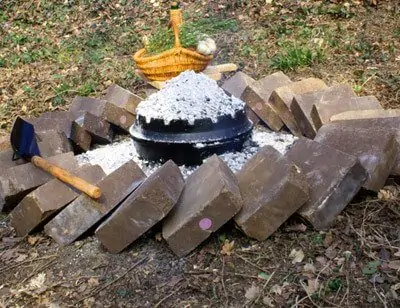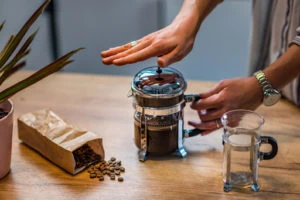The following article on the care of cast iron utensils, by Soc Clay,
is taken from the January/February 1992 issue of The Louisiana
Conservationist.
Black Iron and Black Magic
The Dutch oven and other black iron cooking utensils continue to be essential in hunting and fishing camps across Louisiana. An iron pot with a tight fitting lid is still the prized possession of many camp cooks.
More than a few are also found “back home.” The fancy copper-bottomed and tinted glass cookware may be prominently displayed, but the black iron is tucked away close at hand.
Properly seasoned, a flat-bottomed Dutch oven is an ideal pot to whip up a venison stew, work up a batch of gumbo or jambalaya, fry a mess of quail or bake a round of sourdough biscuits.
>> Wonder about seasoning? Check out the definitive guide to seasoning cast iron.
The late Ted Trueblood, one of America’s most loved hunting scribes, was sold on the dutch oven as being the most important piece of cookware. Trueblood was an open fire cook of the first order. He saw no use whatever in packing in a camp stove and fuel when he was in a serious hunting situation.
Trueblood, writing in the August 1960 issue of Field and Stream, talked about the then-modern equipment available to hunters and fishermen. He said, “Among all these good new items there are a few old ones that survived with undiminished popularity. Almost without exception, they are things that the working outdoorsman adopted as his own. The canoe and the axe are classic examples. The Dutch oven is another old favorite.”
Trueblood’s observations ring true. According to America’s largest manufacturer of black iron cooking utensils, Dutch oven users are thicker than they have been in years. There’s even a Dutch Oven Society and a bunch of Dutch oven cook-offs popping up all over the country.
Amazingly, more and more folks are going back to ironware, not only because of its unique cooking and flavoring characteristics, but also because cast iron has stood the test of ages as one of the safest forms of cookware.
While a dutch oven is still a favorite tool of the open fire cook, probably the most used piece of ironware in today’s camp kitchens is the ever-faithful cast iron skillet. Throughout Louisiana, it is safe to say that at least 80 percent of all households have at least one black iron skillet in regular use.

 Dutch Oven in Action!
Dutch Oven in Action!Ironware was made for the cook who takes time to do things right. The thick walls of the casting were designed to absorb and evenly distribute heat from a licking outdoor flame or the flat top of a wood burning cookstove.
With modern camp stoves fueled by electricity, natural gas or propane the iron pot continues to do a superior job. It just takes less energy than most of the other cookware on the market.
Cookware made of glass, stainless steel, enamel, porcelain or copper, or lined with a space-age non-stick surface, strives to leave no influence of taste in foods. Properly seasoned ironware, on the other hand, emits a savory seasoning “flavor” that no other cookware can duplicate.
But if black iron makes such black magic in the kitchen, how come even more folks ain’t using it?
The answer is simple. Sweetnin’ the pot, as the old timers call it, takes some time and patience. And once the initial job is accomplished, some thought has to be given to maintaining the pot.
>> You can even cook pizza on cast iron.
When done properly, fried foods won’t stick and the bitter taste characteristic of a new casting won’t leak into your food. If you have picked up a new casting, found a treasure at a flea market, or want to recondition a neglected family heirloom, here are some tips I gleaned from an old Cherokee lady who has used black iron to perform black magic in her kitchen for three quarters of a century.
First, inspect your black iron casting for a smooth interior surface.
The finish on the outside is unimportant.
Quality ironware has a smooth interior that readily accepts sweetening and provides a slick surface to eliminate sticking.
Wash the new utensil, or one that has lost its seasoning, both inside and out with a mild dishwashing detergent. New castings come with a protective coating that must be completely removed.
Use a scouring pad if necessary, but this is the last time a black iron utensil should ever see a scouring pad. Dry the casting thoroughly with paper towls and let it air dry for at least 30 minutes
Use unsalted lard or shortening to completely coat the inside and outside of the dry pot or skillet and then bake it in a 350-degree oven for a total of 10 hours. This can be accomplished a few hours at a time while baking other items if you make sure the old grease is wiped clean and a fresh coating is applied each time the pot goes into the oven.
After 10 hours of baking, test the pot by using a little vegetable oil to fry an egg. If the egg sticks, wash the pot lightly with soapy water and a cloth or brush, re-coat it, and bake it for an additional three hours or so.
Then test it again.
The sweetening process allows the porous cast iron to absorb as much grease as possible. When completed, the pot will take on a deep, shiny black finish.
Once the pot has been properly seasoned, never scour it or let the pot sit in soapy water. Never place it in a dishwasher. Old time camp cooks would break your arm for washing a black iron pot at all. They simply wiped it clean and used it frequently to keep it in top condition.
>>Learn about how to care for cast iron the smart way.
When boiling foods in a newly seasoned pot, keep the water content low and be sure to remove the lid from hot foods to avoid steaming the seasoning off the lid.
Once the pot is conditioned, store it in a dry place without the lid on between uses. A paper towel in the pot will absorb moisture. Most folks who use black iron regularly like to apply a light film of cooking oil or grease to the insides during storage.
Finally, when you get ready to pass along that treasured old pot or skillet, be sure the new owner also gets these instructions.
There are other methods for sweetening black iron cookware, but none has ever worked as well for me as the old Cherokee recipe.
Some would say black magic occurs in many forms throughout Bayou Country.
For good cooks, in camp and at home, across Louisiana some of the very best black magic takes form when well seasoned black iron bubbles and sizzles up some of the finest grub in the land.
> Read about the History of Wagner Ware Cast Iron.
Come explore the world of the Kitchen Professor. Head here if you want to see my picks for the best enameled cast iron dutch oven.





Rose Reinhard is a Thai-American foodie from Chiang Mai, Thailand. She's been a creative writer since she could speak and enjoys making vegetarian/vegan dishes and reading about food science. She claims her air-fryer is the best purchase she’s ever made to date.